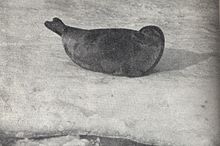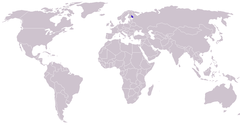Saimaa ringed seal: Difference between revisions
Rescuing 1 sources and tagging 0 as dead. #IABot (v1.6.5) |
Nazarioe11 (talk | contribs) Added behavior section and included information about their dive behavior. |
||
| Line 26: | Line 26: | ||
An adult Saimaa ringed seal is between {{convert|85|and|160|cm|ft}} in length and weighs between {{convert|50|and|90|kg|lb}}; males usually being larger than females. They are coloured dark gray, with a gray-black dorsal with circular white rings. The bottom is light gray. The Saimaa ringed seal is darker in color than other ringed seals. |
An adult Saimaa ringed seal is between {{convert|85|and|160|cm|ft}} in length and weighs between {{convert|50|and|90|kg|lb}}; males usually being larger than females. They are coloured dark gray, with a gray-black dorsal with circular white rings. The bottom is light gray. The Saimaa ringed seal is darker in color than other ringed seals. |
||
== |
==Behavior== |
||
===Reproduction=== |
|||
Saimaa ringed seals become mature between the ages of 4 and 6 on average. Their pregnancy rate is between 80 and 95 percent. Ringed seals' gestation lasts 11 months. Their pups are between {{convert|55|and|65|cm|ft}}, and {{convert|4|to|5|kg|lb}} at birth. The Saimaa ringed seal's longevity is just over 20 years. |
Saimaa ringed seals become mature between the ages of 4 and 6 on average. Their pregnancy rate is between 80 and 95 percent. Ringed seals' gestation lasts 11 months. Their pups are between {{convert|55|and|65|cm|ft}}, and {{convert|4|to|5|kg|lb}} at birth. The Saimaa ringed seal's longevity is just over 20 years. |
||
=== '''Diving''' === |
|||
[[File:5FinnischeMark Vorderseite.jpg|thumb|Saimaa ringed seal featured on the Finnish 5 [[Finnish markka|markka]] coin.]] |
|||
Diving is an important behavior for marine mammals as it is something they rely on for behaviors such as foraging and travelling. The duration of their dives increases from spring to autumn, which may be a result of food availability, but is interesting because they are one of the few land locked seal species <ref name=":0">{{Cite journal|last=Hyvarinen|first=Heikki|last2=Hamalainen|first2=Esa|last3=Kunnasranta|first3=Mervi|date=1995-07|title=DIVING BEHAVIOR OF THE SAIMAA RINGED SEAL (PHOCA HISPIDA SAIMENSIS NORDQ.)|url=http://dx.doi.org/10.1111/j.1748-7692.1995.tb00288.x|journal=Marine Mammal Science|volume=11|issue=3|pages=324–334|doi=10.1111/j.1748-7692.1995.tb00288.x|issn=0824-0469}}</ref>. Many studies have been done to observe saimaa ringed seal diving, and has been discovered to last longer than expected. Their average time for a long dive was recorded to last for 15 min and was believed to be an aerobic resting dive<ref name=":1">{{Cite journal|last=Kunnasranta|first=Mervi|last2=Hyvärinen|first2=Heikki|last3=Häkkinen|first3=Jani|last4=Koskela|first4=Jouni T.|date=2002-03|title=Dive types and circadian behaviour patterns of Saimaa ringed sealsPhoca hispida saimensis during the open-water season|url=http://dx.doi.org/10.1007/bf03193567|journal=Acta Theriologica|volume=47|issue=1|pages=63–72|doi=10.1007/bf03193567|issn=0001-7051}}</ref>. |
|||
The average dive depth ranged from 10 to 15 m, however, their maximum dive depths were limited by environmental depth<ref name=":1" />. The saimaa ringed seal has also been observed to have seasonal [[hauling-out]] patterns. In May and June, when the seals are [[Moulting|molting]], they are observed to haul out both day and night, however, in late summer they are only observed to haul out at night<ref name=":0" />. |
|||
The saimaa ringed seal is able to complete their dives and navigate in their environment due to their highly developed [[vibrissae]], also known as whiskers. Using their vibrissae they are able to detect sound and pressure waves in their otherwise dark environment<ref>{{Cite journal|last=HYVÄRINEN|first=HEIKKI|date=1989-08|title=Diving in darkness: whiskers as sense organs of the ringed seal(Phoca hispida saimensis)|url=http://dx.doi.org/10.1111/j.1469-7998.1989.tb05008.x|journal=Journal of Zoology|volume=218|issue=4|pages=663–678|doi=10.1111/j.1469-7998.1989.tb05008.x|issn=0952-8369}}</ref>.[[File:5FinnischeMark Vorderseite.jpg|thumb|Saimaa ringed seal featured on the Finnish 5 [[Finnish markka|markka]] coin.]] |
|||
==Conservation== |
==Conservation== |
||
Revision as of 00:40, 23 May 2018
| Saimaa ringed seal | |
|---|---|

| |
| Scientific classification | |
| Kingdom: | |
| Phylum: | |
| Class: | |
| Order: | |
| Family: | |
| Genus: | |
| Species: | |
| Subspecies: | P. h. saimensis
|
| Trinomial name | |
| Pusa hispida saimensis (Nordquist, 1899)
| |

| |
| Synonyms | |
|
| |
The Saimaa ringed seal (Finnish: Saimaannorppa) is a subspecies of ringed seal (Pusa hispida). They are among the most endangered seals in the world, having a total population of only about 380 individuals.[2] The only existing population of these seals is found in Lake Saimaa, Finland (hence the name). The population is descended from ringed seals that were separated from the rest when the land rose after the last ice age. This seal, along with the Ladoga seal and the Baikal seal, is one of the few living freshwater seals.
Appearance

An adult Saimaa ringed seal is between 85 and 160 centimetres (2.79 and 5.25 ft) in length and weighs between 50 and 90 kilograms (110 and 200 lb); males usually being larger than females. They are coloured dark gray, with a gray-black dorsal with circular white rings. The bottom is light gray. The Saimaa ringed seal is darker in color than other ringed seals.
Behavior
Reproduction
Saimaa ringed seals become mature between the ages of 4 and 6 on average. Their pregnancy rate is between 80 and 95 percent. Ringed seals' gestation lasts 11 months. Their pups are between 55 and 65 centimetres (1.80 and 2.13 ft), and 4 to 5 kilograms (8.8 to 11.0 lb) at birth. The Saimaa ringed seal's longevity is just over 20 years.
Diving
Diving is an important behavior for marine mammals as it is something they rely on for behaviors such as foraging and travelling. The duration of their dives increases from spring to autumn, which may be a result of food availability, but is interesting because they are one of the few land locked seal species [3]. Many studies have been done to observe saimaa ringed seal diving, and has been discovered to last longer than expected. Their average time for a long dive was recorded to last for 15 min and was believed to be an aerobic resting dive[4].
The average dive depth ranged from 10 to 15 m, however, their maximum dive depths were limited by environmental depth[4]. The saimaa ringed seal has also been observed to have seasonal hauling-out patterns. In May and June, when the seals are molting, they are observed to haul out both day and night, however, in late summer they are only observed to haul out at night[3].
The saimaa ringed seal is able to complete their dives and navigate in their environment due to their highly developed vibrissae, also known as whiskers. Using their vibrissae they are able to detect sound and pressure waves in their otherwise dark environment[5].
Conservation
The Saimaa ringed seal has been protected since 1955. In 1983, the population was between 100 and 150 seals. In 2005, it was about 270, but as a result of two unfavorable breeding seasons, 2006 and 2007, the number dropped down to 260. In 2013 the population was estimated at just over 300 and the population numbers were in a slight growth. The number of breeding-aged females was 87.[6] It is thought that the immediate threat of extinction would be alleviated if the population grew to over 400 individuals. It is listed as endangered by the U.S. government under the Endangered Species Act.
In spring 2016, 79 pups were found, four of which were dead.[7]
In order to protect the Saimaa ringed seal, there are voluntary fisheries restrictions in a part of their living areas. The most important form of restriction is a ban for fishing nets from April 15 to the end of June in about 15% of the lake; nearly all fishing is recreational. Bycatch mortality has, however, remained high with estimated mortality of 20–30 seals annually, most of them pups of the same year.
To reduce the by-catch mortality of seals aged over one year, it has been banned since 2011 to use certain fishing methods, such as strong mesh nets, large fish traps, and fish-baited hooks, in the main part of the Saimaa ringed seal’s habitat.[8]
In 2016, one act and mutual agreements between authorities and owners of fishing waters replace earlier two acts. The fishing co-operatives get 1.7 euros per hectare to monitor that fishing limitations are followed. Net fishing (except of vendace nets) is forbidden between 15 April and end of June in certain areas, which have been drawn at 5 km radius from nesting sites.[9]
Breeding success of Saimaa ringed seal depends on sufficient ice and snow cover. The loss of snow and ice caused by the ongoing climate change poses a direct threat to them. Human-made snowdrifts have proved to be successful in improving seals' breeding success during winters with poor snow conditions.[10] Snowdrifts were tested for three winters, and from 2014 they have been used regularly.[11][12]
Target of the protection is to have 400 ringed seals in Saimaa by year 2020.[13]
The Saimaa ringed seal lives nowadays mainly in two Finnish national parks, Kolovesi and Linnansaari.[14] Strays have been seen in a much larger area, including Savonlinna centre.
References
- ^ "Endangered and Threatened Species under NMFS' Jurisdiction" (PDF). United States Fish & Wildlife Service. 6 April 2010. Retrieved 11 November 2010.
- ^ "Ultra-rare Saimaa seal population recovers slowly". Retrieved 10 January 2013.
- ^ a b Hyvarinen, Heikki; Hamalainen, Esa; Kunnasranta, Mervi (1995-07). "DIVING BEHAVIOR OF THE SAIMAA RINGED SEAL (PHOCA HISPIDA SAIMENSIS NORDQ.)". Marine Mammal Science. 11 (3): 324–334. doi:10.1111/j.1748-7692.1995.tb00288.x. ISSN 0824-0469.
{{cite journal}}: Check date values in:|date=(help) - ^ a b Kunnasranta, Mervi; Hyvärinen, Heikki; Häkkinen, Jani; Koskela, Jouni T. (2002-03). "Dive types and circadian behaviour patterns of Saimaa ringed sealsPhoca hispida saimensis during the open-water season". Acta Theriologica. 47 (1): 63–72. doi:10.1007/bf03193567. ISSN 0001-7051.
{{cite journal}}: Check date values in:|date=(help) - ^ HYVÄRINEN, HEIKKI (1989-08). "Diving in darkness: whiskers as sense organs of the ringed seal(Phoca hispida saimensis)". Journal of Zoology. 218 (4): 663–678. doi:10.1111/j.1469-7998.1989.tb05008.x. ISSN 0952-8369.
{{cite journal}}: Check date values in:|date=(help) - ^ Partio, Elina (2013-09-13). "Saimaannorpan kanta kasvussa".
- ^ "Saimaalta löytyi 79 kuuttia, mikä on ennätysmäärä". Maatalouden Tulevaisuus (in Finnish). 2016-04-15. Retrieved 2016-05-01.
- ^ "A New Protection Strategy for the Saimaa Ringed Seal, Due to Climate Change" (PDF). Metsähallitus - Natural Heritage Services, Eastern Finland. 2011. Retrieved 2016-05-01.
- ^ "Kalastusrajoitukset voimaan saimaannorpan suojelemiseksi". Ministry of Agriculture (in Finnish). 2016-04-14. Retrieved 2016-05-01.
- ^ "Human intervention can help endangered Saimaa ringed seal adapt to climate change". Science Daily. 2015-11-05. Retrieved 2016-05-01.
- ^ "Apukinoksen teko norpan pesinnän suojaksi on tarkkaa puuhaa - Katso video!". Länsi-Savo (in Finnish). 2014. Retrieved 2016-05-01.
- ^ "Saimaannorpan luonnonpesintä on vaarassa, apukinosten kasaamisesta päätetään pian". hs.fi (in Finnish). 2016. Retrieved 2016-05-01.
- ^ "Saimaa Ringed Seal" (PDF). Metsähallitus - Natural Heritage Services, Eastern Finland. Retrieved 2016-05-01.
- ^ "Welcome to Linnansaari and Kolovesi National Parks". Järvisydän. 2016. Retrieved 2016-05-01.

